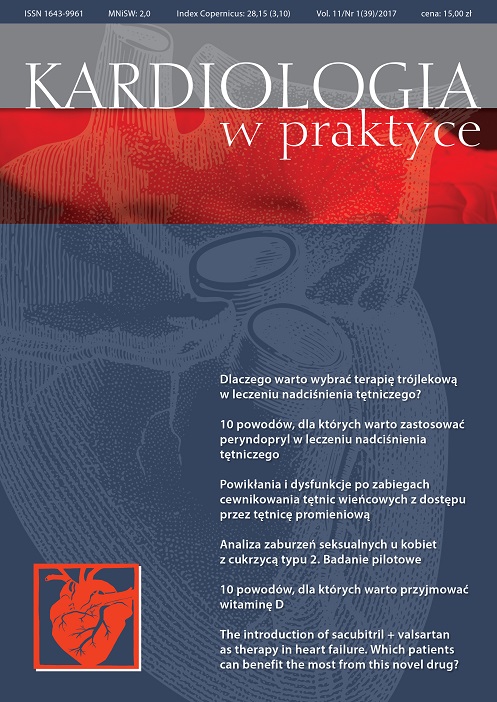Complications and dysfunctions after coronary artery catheterization with radial artery access Review article
Main Article Content
Abstract
Coronary artery angioplasty is increasingly being performed by radial artery access. Compared to femoral access, radial access is characterized by less number of complications and it can reduce the patient’s hospitalization time. However, complications after catheterization of coronary arteries by radial artery also happen. Usually these are hematoma at the site of the artery puncture, less often happens severe dysfunction of the upper limb due to pain or paraesthesia. Rare complications include weakness or loss of pulse on the radial artery after surgery. There is still a lack of research on complications in the functioning of the upper limb after surgery and how to cope with it. According to many specialists cardiological rehabilitation after angioplasty of coronary vessels should be an integral part of the proceedings.
Downloads
Article Details

This work is licensed under a Creative Commons Attribution-NonCommercial 4.0 International License.
Copyright: © Medical Education sp. z o.o. This is an Open Access article distributed under the terms of the Attribution-NonCommercial 4.0 International (CC BY-NC 4.0). License (https://creativecommons.org/licenses/by-nc/4.0/), allowing third parties to copy and redistribute the material in any medium or format and to remix, transform, and build upon the material, provided the original work is properly cited and states its license.
Address reprint requests to: Medical Education, Marcin Kuźma (marcin.kuzma@mededu.pl)
References
2. Gralak-Łachowska D., Lewandowski P.: Dostępy naczyniowe w kardiologii inwazyjnej. Postępy Nauk Medycznych 2015; 28(11B): 74-78.
3. Jolly S.S., Yusuf S., Cairns J. et al.: Radial versus femoral access for coronary angiography and intervention in patients with acute coronary syndromes (RIVAL): a randomised, parallel group, multicentre trial. Lancet 2011; 307: 1409-1420.
4. Sinha S.K., Mishra V., Afdaali N. et al.: Coronary Angiography Safety between Transradial and Transfemoral Access. Cardiol. Res. Pract. 2016. http://doi.org/10.1155/2016/4013843.
5. Hassel J., Piek J.J.: Upper-extremity dysfunction following transradial percutaneous procedures: an overlooked and disregarded complication? Neth. Heart J. 2015; 23: 510-513.
6. West R., Ellis G., Brooks N.: Complications of diagnostic cardiac catheterisation: results from a confidential inquiry into cardiac catheter complications. Heart 2006; 92: 810-814.
7. Rademakers L.M., Laarman G.J.: Critical hand ischaemia after transradial cardiac catheterisation: an uncommon complication of a common procedure. Neth. Heart J. 2012; 20: 372-375. http://doi.org/10.1007/s12471-012-0276-8.
8. Tylkowski M., Kośmider M.: Znaczenie wykorzystania dostępu przez tętnicę promieniową w leczeniu metodą angioplastyki pacjentów z ostrymi zespołami wieńcowymi. Kardiologia Oparta na Faktach 2010; 1: 51-56.
9. Shroff A., Siddiqui S., Burg A., Singla I.: Identification and Management of Complications of Transradial Procedures. Curr. Cardiol. Rep. 2013; 15: 350.
10. Tuncez A., Kaya Z., Aras D. et al.: Incidence and Predictors of Radial Artery Occlusion Associated Transradial Catheterization. Int. J. Med. Sci. 2013; 10: 1715-1719.
11. Sciahbasi A., Rigattieri S., Sarandrea A. et al.: Radial Artery Occlusion and Hand Strength After Percutaneous Coronary Procedures: Results of the HANGAR Study. Catheter. Cardiovasc. Interv. 2016; 87: 868-874.
12. Zwaan E.M., Koopman A.G., Holtzer C.A. et al.: Revealing the impact of local access-site complications and upper extremity dysfunction post transradial percutaneous coronary procedures. Neth. Heart J. 2015; 23: 514-524.
13. Araki T., Itaya H., Yamamoto M.: Acute compartment syndrome of the forearm that occurred after transradial intervention and was not caused by bleeding or hematoma formation. Catheter. Cardiovasc. Interv. 2010; 75: 362-365.
14. van Leeuwen M.A., van Mieghem N.M., Lenzen M.J. et al.: The effect of transradial coronary catheterization on upper limb function. JACC Cardiovasc. Interv. 2015; 8(4): 515-523. http://doi.org/10.1016/j.jcin.2014.10.025.
15. Goel K., Lennon R.J., Tilbury R.T. et al.: Impact of Cardiac Rehabilitation on Mortality and Cardiovascular Events After Percutaneous Coronary Intervention in the Community. Circulation 2011; 2344-2352.
16. Lee Y.H., Hur S.H., Sohn J. et al.: Impact of Home-Based Exercise Training with Wireless Monitoring on Patients with Acute Coronary Syndrome Undergoing Percutaneous Coronary Intervention. J. Korean Med. Sci. 2013; 28: 564-568.
17. Yu R.X., Muller-Riemenschneider F.: Effectiveness of exercise after PCI in the secondary prevention of coronary heart disease: A systematic review. Eur. J. Integr. Med. 2011; 3: e63-e69.
18. Yang X., Li Y., Ren X. et al.: Effects of exercise-based cardiac rehabilitation in patients after percutaneous coronary intervention: A meta-analysis of randomized controlled trials. Sci. Rep. 2016; 7: 44789. http://doi.org/10.1038/srep44789.
19. Pourafkari L., Ghaffari S., Shahamfar J. et al.: The psychological effects of cardiac rehabilitation after coronary revascularization. Turk. Kardiyol. Dern. Ars. 2016; 44(3): 228-236.

